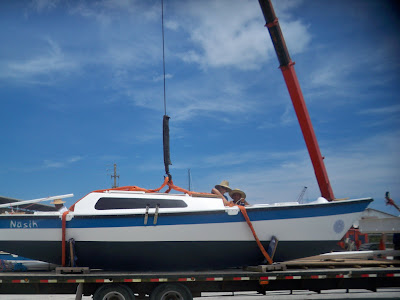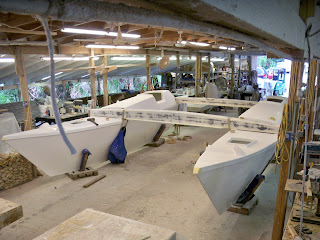We have finished the Tiki 8m #4. Here are some photos of her being assembled at Crackerboy Boat Works in Riviera Beach FL. She sure looks sweet!!
The boat has been named Nasir. This is an old god who is the transformer of men's souls. The owner is from the Mediterranean originally and they put eyeballs on the front of their boats to help them find their way home.
This is Richard Binstock the owner of this boat. He is a level II free diving instructor. He is starting a free diving school in Nassau, Bahamas. You can go out and learn to go deeper than you ever thought and then stay on his converted PT. He is also an excellent chef. He stayed with us for the last several weeks while we finished his boat and we sure ate well. http://www.karnakfloatingstudios.com/about/pricing.html
The boat has been named Nasir. This is an old god who is the transformer of men's souls. The owner is from the Mediterranean originally and they put eyeballs on the front of their boats to help them find their way home.
This is Richard Binstock the owner of this boat. He is a level II free diving instructor. He is starting a free diving school in Nassau, Bahamas. You can go out and learn to go deeper than you ever thought and then stay on his converted PT. He is also an excellent chef. He stayed with us for the last several weeks while we finished his boat and we sure ate well. http://www.karnakfloatingstudios.com/about/pricing.html
This boat has the Colligo deadeyes. They are so cool.
We lash the beams with regular polyester stayset and them frap them with Dynex Dux. The Dynex is low stretch and very slippery and we can get the lashings very tight. We will hook up a 4 to 1 purchase on the tail of this frapping and pull like a bull.
We have installed the tramps and the foredeck
Here we have the Bimini on and the boat is launched. She needs to have the waterline raised in the front by a couple of inches. She does have 20 gallons of gas and an electric bicycle on the foredeck but a little more paint is in order.
Here we are in the morning ready to take off for Nassau. Does he look happy or what?
This shot shows the cockpit and the bimini. The bimini really worked out well. It provides a lot of shade and also provides lots of handholds while moving about in the cockpit and especially while entering and exiting the cabins. There is sitting headroom underneath and standing headroom behind it. In this part of the world shade is not an option IMO.
This delivery served as the sea trial for this vessel. Not the ideal way to do it but it worked out OK. There were a few minor things to deal with but nothing serious and Richard is most delighted with his new boat. We motored most of the way over and sailed for only a few hours while on the banks between Cat Cay and Nassau. I will have some more photos of her under sail in the near future. A week after she arrived home hurricane Irene payed a visit to her and I am happy to be able to say that she survived unscathed.

























































